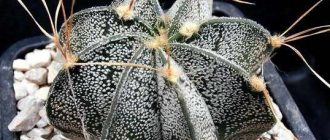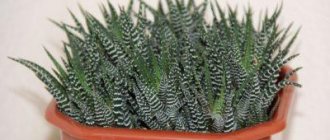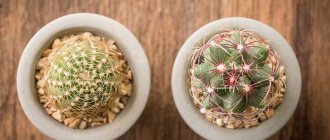Wintering cacti in nature
In the wild, cacti live in arid and heavily sunlit areas. These are the deserts of Africa, Asia, North and South America. Plants tolerate large temperature changes, which can reach 50 °C. They are able to accumulate moisture and survive in conditions of elevated ambient temperatures - up to +60°C. But the main feature of plants is their adaptability to a small amount of incoming water. The precipitation rate in deserts is most often 200-300 mm/year.
In places where cacti grow, temperature fluctuations are most often observed in winter. At night after a hot day there are frosts, because the heated soil quickly cools down.
Pests and diseases of cacti
Cacti are very attractive to spider mites. Do not wait for external manifestations of damage; treat plants prophylactically twice a year - in spring and autumn - with acaricides. Indoors you can use Fitoverm, Apollo, Vermitek, outdoors - Actellik. Another pest that poses a serious threat is mealybugs and rootbugs. Treatment with a systemic insecticide (Intavir, Actellik) helps against them. Change medications to prevent insects and mites from developing resistance to them.
Caring for cacti in winter at home
These plants are unpretentious and require minimal care from the owner. However, those that are always kept in a warm room will never bloom, with the exception of certain species. High temperatures cannot compensate for the decrease in daylight hours that occurs in winter. As a result, most cacti, without wintering, do not bloom, stretch out, and lose their attractiveness. During rest, the foundation is laid for future buds and preparations for the future growing season are underway.
Winter maintenance of cacti at home comes down to gradually stopping watering and ensuring coolness.
Temperature
To organize winter hibernation, prickly plants need to create a temperature from +5 to +15 °C. This range is most suitable in dry conditions to ensure the dormancy necessary for further development and flowering of plants. At night, a drop in temperature is acceptable.
The possible temperature range varies depending on the type of cacti. Many of them can withstand short-term frosts from -2 to -4 °C. Some plant species can tolerate cold down to -35 °C. However, most of them cannot tolerate sub-zero temperatures.
It is difficult to create such conditions at home. There are several options for this. The first of them is to create a suitable microclimate on the glazed loggia. If necessary, it is insulated with polystyrene foam, cracks are sealed or windows are replaced, and plants are wrapped.
The second way to organize wintering is a mini-greenhouse made of plexiglass or film on the windowsill. To do this, a frame made of beams or thin slats is attached to wooden frames using metal corners and the cacti are protected from the warm air of the heating radiators. The necessary cold comes from the glass. You can control the temperature in such a mini-greenhouse using a thermometer. In summer, the structure is removed and the corners are covered with curtains.
For a large collection, you can make a shelf inside a mini-greenhouse. For this, it is good to use PVC siding for cladding ceilings. The legs are made of the same material, which is secured with screws.
The third method, tested by amateur gardeners: in the winter, place the plants in a cold cabinet in the kitchen or an insulated box on the loggia. Despite the lack of light, cacti tolerate such wintering well, provided that the required temperature range is maintained.
Single plants can be covered with a plastic cap to protect them from the heat of radiators. At the same time, for wintering it is desirable to come into contact with cold glass to ensure the desired temperature.
The organization of a low-temperature regime must necessarily be accompanied by a lack of watering. This is the only way to create conditions close to those that cacti endure in nature.
If the plants have been wintering on the loggia and suddenly there is warming that does not go away after 1-2 days, you have to stop hibernation and start watering them.
Humidity and watering
It is important to provide wintering cacti with as dry conditions as possible. Fogging single hoods are wiped regularly. In a mini-greenhouse, ventilation is carried out due to the loose fit of the side walls of the greenhouse to the window.
Before sending the plants for winter, you need to spray them every day for 2 weeks, but under no circumstances water them. By the time sleep sets in, the soil in the plants’ pots should be dry.
Ambient temperature and the amount of incoming moisture are closely related. The combination of cold and lack of water creates conditions for winter hibernation of plants, which lasts from 2-3 to 5 months. Therefore, you should not water the plants at this time. They shrink a little and sag, but this is normal. And only if the cactus is very wrinkled and withered, you can add a few drops of water from a pipette, no more than a teaspoon. It is poured away from the stem, along the edge of the pot no more than once every 2-4 weeks.
It is also better to exit from sleep mode gradually, increasing the temperature and moisture supply. First, the plants begin to be sprayed, then drip watering is carried out and, gradually increasing, they are brought to the summer volume. You need to make sure that the plant does not get sunburn. Those cacti that were in the dark in winter must first be shaded a little by covering them with newspaper, curtains, etc.
Most cacti need to be watered 1-2 times a month with a small amount of settled water. However, the need for moisture depends on the type of plant.
The following plants require drip watering even during hibernation:
- acanthocalycium;
- brasilopuntia;
- Weberocereus;
- Gymnocalycium;
- Hylocereus;
- discocactus;
- Cleistocactus;
- coleocephalocereus;
- quabentia;
- lepismium;
- myrtilocactus;
- notocactus;
- pilosocereus;
- rhipsalis;
- Telocactus;
- Harrisia;
- hatiora;
- cylindropuntia;
- Schlumberger;
- Echinofossulocactus.
Overwatering can cause the roots or lower part of the plant stem to rot. They are removed and the cactus is replanted.
Feeding
In winter, fertilizers are not applied to the soil of cacti. They can be added in the spring and summer, ending in September.
How often should you moisten the soil under a cactus?
When a gardener has cacti at home, but knows only general information about them, he begins to come up with watering schedules himself. Most often, such people are divided into two categories:
- The first category includes gardeners who are opposed to frequent watering. In their opinion, the cactus is a desert inhabitant, so it is freely able to grow for a long time without water.
- The second category includes flower growers who love the golden mean. They do not over-moisten the soil, but regularly water the flower with a small amount of water.
In both cases, flower growers make a grave mistake. There are certain requirements for watering these plants that must be met.
Advice! Cacti are easy to care for for a grower who understands their basic needs.
The frequency of watering a succulent depends on its variety. Common cacti are the most common among gardeners. They need to be watered only during active growth and flowering. It is equally important to determine the amount of water. The more active growth is observed, the more moisture the plant requires.
To determine whether a cactus needs to be watered or whether it does not yet require water, one must analyze the environment. When flowers stand on window sills in a hot room near heating radiators, moisture leaves their fleshy stems faster. Under such conditions, the frequency of soil moisture increases. Inside a cool room, where the air temperature is about +10°C, the plant’s metabolism stops. The succulent does not absorb water at all, so watering is not necessary. Moisture can only rot the roots. Here the question may arise, why then keep the flower cool. This should be done during winter dormancy.
Advice! In order not to get confused with watering, it is easier to look at the time of year. From October to early March, most cacti have a dormant period. They are placed in a cool room and not watered until early spring.
There is a variety of tropical cacti that do not need cool conditions. Sometimes even ordinary succulents continue to be kept on the windowsill in a warm room in winter. Under such conditions, plants need watering, but minimal. Under each succulent, regularly pour 1 tbsp after 7 days. l. water. Most often, such cacti are grown in clay pots. They are placed inside a volumetric box, where the voids between the flower beds are filled with peat. The filler is considered moisture-intensive. When watering in winter, only peat is moistened. In spring, cacti begin to grow. However, they are also not watered immediately. Initially, the succulent is sprayed with warm water. During the shower, the dust is washed off. The plant grows lateral roots designed to absorb moisture from the soil surface.
See also: Hydrangea: description of the plant, planting and care in open ground, selection of seedlings
Cactus blooming in winter
Some types of cacti are able to bloom in winter:
- aporocactus;
- Gymnocalycium;
- melocactus;
- mamillaria;
- notocactus;
- parody;
- rhipsalis.
However, even they need a period of winter rest, which lasts from October to February. The amount of incoming water is sharply reduced to a few drops once a month, fertilizing is completely eliminated. The buds of these plants are laid in December, and in some species - in October or November.
Fertilizing: how and with what to fertilize cacti
If a slow-release granular fertilizer was not added at planting, use a liquid cactus or succulent fertilizer according to the manufacturer's instructions during the summer active growing season. Do not feed cacti with mineral fertilizers with a high nitrogen content and organic fertilizers (humus, manure, litter, sapropel, compost). Excess nitrogen leads to deformation of stems, tissue ruptures, plants weaken and lose resistance to diseases and pests.
Transplanting cacti in winter
In winter, cacti tolerate transplantation well, because they are at rest and do not grow. The best time for this is considered to be late winter. The basic rule is the complete absence of moisture. The plants are transferred to the dry mixture and not watered. For replanting, special soil for cacti is used, containing a large amount of sand to imitate natural conditions.
Healthy adult plants are replanted once every 3 years. However, there are times when you need to do this more often: when purchasing, injury, fall or rotting roots. In clay pots, moisture evaporates faster, so cacti planted in them need to be replanted once a year.
Features of the Strait of Cacti
In spring and summer, cacti need abundant watering. The frequency depends on the speed of soil drying. When kept outdoors on hot summer days, properly composed soil dries out in 3-4 days, and the cacti are watered weekly, but only after making sure that the soil is completely dry. At this time, cacti need water not only for nutrition, but also for cooling the stem due to evaporation. In winter, cacti are kept at low temperatures without watering at all. Dry, cold wintering is a necessary condition for annual flowering.
Water quality requirements
Almost all plants do not like hard water. In most regions, tap water is not of high quality. It is necessary to defend it. The best option would be to purchase a filter that removes chlorine well. For hard water, boiling is also allowed.
If you have access to distilled water, you can use it. However, this method may be too expensive.
If possible, take melt or rain water. A good option for residents of private houses who have the opportunity to go outside at any time. This liquid is ideal for watering. Plants receive moisture with an identical composition under natural conditions.
Watering Basics
Cacti grow in unusual climatic conditions, so there are special requirements for their watering. This matter has its own subtleties, which are associated with the cyclical nature of the plant. Some specimens growing in the desert are capable of accumulating more than one thousand liters of water.
Watering can be done in two ways:
- Standard watering from a watering can with a thin spout or other container.
- Water is poured into the pan of the pot. Through the drainage holes, the soil will absorb as much moisture as necessary.
Floriculture experts say that there is not much difference in how to water a cactus. You can alternate between different methods or give preference to the one that is comfortable in a particular case.
Avoid getting water on the plant stem. Excess moisture causes more harm than lack of moisture. Be sure to ensure that water does not stagnate in the pan.
Water temperature
The cactus will feel comfortable if the water temperature is suitable. For irrigation, it should be 5-7 C higher than the room temperature.
Other experts are of the opinion that the best option for watering is a liquid with a temperature of 30-40 C at any thermometer in the room.
For spraying, use hotter water. It cools down quickly during irrigation. Cacti love this type of moisture. It is advisable to choose a fine spray nozzle.
To water plants with melt or rain water, it is advisable to pre-heat it in the sun.
Description of the plant
From a botanical point of view, almost all representatives of the Cactus family are nothing special; one might even say that these are very primitive plants
Succulents with reduced leaves, whose dense tissues are adapted to accumulate liquid reserves - what could be simpler...
However, due to the variety of external forms, representatives of this family occupy a worthy place both in landscape design and in indoor floriculture.
The diversity of structure, as well as the size of the shoots, the direction of their growth, the ability to branch, etc., have led to the fact that in the family there are peculiar “analogs” of almost all representatives of the plant world, as well as several of their own forms, inherent only to Cacti
To put it simply, the same anatomy and physiology of cacti is not at all a hindrance to their external diversity and unique, incomparable exterior. Well, don’t forget about another important property of these plants. Most of them have beautiful and bright flowers.
The cactus trunk is a fleshy body filled with water. Its dimensions can vary - from 1 cm to 20 m. The leaves of the cactus are reduced and are thin, pointed branches of short length, called spines. They grow from areoles - small modified axillary buds.
Some species of cacti (Echinocerus crestata, Hatiora, Lophophora, etc.) may have no spines at all. Others (for example, Astrophytum capricornus), on the contrary, have very long spiny shoots up to 7 cm long.
Cactus flowers and fruits have an original structure: part of the flower, bud and fruit are also part of the stem.
Unusually shaped areoles on tree-like varieties of cacti
The root system of the plant is also reduced and consists of a rod with several small branches. Sometimes it consists of 5-6 short roots. Only in large species is it similar to the branched root system of trees.
The homeland of all cacti is America, but thanks to people from there, they have spread throughout the world. Mostly cacti are heat-loving plants, but some species can climb far from warm places. The most extreme species, capable of withstanding relatively cold winters, grow in Canada and southern Argentina (57° north and 50° south latitude, respectively).
Among cactus growers, there is a conditional division of the family into three groups:
- desert
- forest
- indoor
Desert species can differ significantly from forest species and require different growing conditions. As for indoor ones, everything is a little simpler with them: most of them are bred artificially through cross-selection and feel normal in apartments and houses.
Typical representatives of desert cacti are:
- Echinopsis
- Echinocereus
- various echinocacti
- astrophytums
- prickly pear
- rebutions
- mammillaria
- etc.
Echinopsis is the most common genus of desert cactus grown at home.
All desert cacti are drought-resistant plants and can survive without watering for up to six months. They are not afraid of sunburn, and in general, the more direct sunlight there is in the life of this species, the better.
The variety of forest cacti suitable for indoor growing is somewhat more modest. This is due to the fact that in natural wild conditions they grow on the trunks of other trees, and not all of them can be adapted to home conditions.
Typical representatives of forest cacti grown at home:
- rhipsalidopsis
- zygocactus
- aporocactus
- epiphyllum
Unlike desert cacti, forest cacti, although they are light-loving, do not tolerate direct sunlight. It is recommended to place them in partial shade, or use diffused lighting. These varieties, although they are able to tolerate drought, are not as long-lasting as desert ones.











